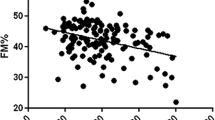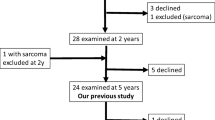Abstract
Background
The mechanisms by which increased body weight influence bone mass density (BMD) are still unknown. The aim of our study was to analyze the relationship between anthropometric and body composition variables, insulin growth factor-I (IGF-I), adiponectin and soluble tumor necrosis factor-α receptors (sTNFR) 1 and 2 with BMD in two cohorts of morbid obese patients, before and after bypass surgery.
Methods
The first cohort included 25 women aged 48 ± 7.6 years studied before bypass surgery. The second included 41 women aged 46 ± 9.2 years, 12 months after surgery. We studied anthropometric variables obtained from whole body DEXA composition analysis. Serum IGF-I, intact serum parathyroid hormone, 25-hydroxivitamin D3, plasma adiponectin concentrations, sTNFR1, sTNFR2 concentrations were measured.
Results
In the first cohort, the BMI was 44.5 ± 3.6 kg/m2, parathyroid hormone, IGF-I, and adiponectin concentrations were lower, and sTNFR1 concentrations were higher than in the second cohort. In the multiple regression analysis, BMD remained significantly associated with body fat percentage (β −0.154, p = 0.01), lean mass (β 0.057, p = 0.016) and phosphate concentration (β 0.225, p = 0.05). In the second cohort, BMI was 31 ± 5.1 kg/m2. In the multiple regression analysis, BMD remained significantly associated with lean mass (β 0.006, p = 0.03).
Conclusion
The inverse correlation found between body fat and BMD in the first cohort indicates morbid obesity increases the risk of osteoporosis and we found a positive correlation with lean and fat mass before bariatric surgery and with lean mass after bypass surgery.
Similar content being viewed by others
References
Tremollieres FA, Pouilles JM, Ribot C. Vertebral postmenopausal bone loss is reduced in overweight women: a longitudinal study in 155 early postmenopausic women. J Clin Endocrinol Metab. 1993;77:683–6.
Morberg CM, Tetens I, Black E, et al. Leptin and bone mineral density: a cross-sectional study in obese and non obese men. J Clin Endocrinol Metab. 2003;88:5795–800.
Trayhurn P, Beattie JH. Physiological role of adipose tissue: white adipose tissue as an endocrine and secretory organ. Proc Nutr Soc. 2001;60:329–39.
Kleerekoper M, Nelson DA, Peterson EL, et al. Body composition and gonadal steroids in older white and black women. J Clin Endocrinol Metab. 1994;79:775–9.
Reid D, Evans M, Cooper G, et al. Circulating insulin levels are related to bone density in normal postmenopausal women. Am J Physiol. 1993;265:293–7.
Gómez JM. Sex and age differences in serum leptin, insulin-like growth factor-I components and sex-hormone binding globulin in a healthy population. Prot Pept Lett. 2007;14:708–11.
Gómez JM, Maravall FJ, Gómez N, et al. The IGF-I system component concentration that decrease with ageing are lower in obesity in relationship to body mass index and body fat. Growth Horm & IGF Res. 2004;14:91–6.
Vendrell J, Broch M, Vilarrasa N, et al. Resistin, adiponectin, ghrelin, leptin and proinflammatory cytokines: relationships in obesity. Obes Surg. 2004;12:962–71.
Vilarrasa N, Vendrell J, Maravall J, et al. Distribution and determinants of adiponectin, resistin and ghrelin in randomly selected healthy population. Relationship with IGF-I system. Clin Endocrinol (Oxf). 2005;63:329–35.
Díez JJ, Iglesias P. The role of the novel adipocyte-derived hormone adiponectin in human disease. Eur J Endocrinol. 2003;148:293–300.
Hotamisligil GS, Arner P, Caro JF, et al. Increased adipose tissue expression of tumor necrosis alpha in human obesity and insulin resistance. J Clin Invest. 1995;95:2409–15.
Wood IS, Wang B, Jenkins JR, Trayhurn P. The pro-inflammatory cytokine IL-18 is expressed in human adipose tissue and strongly upregulated by TNF alpha in human adipocytes. Biochem Biophys Res Commun. 2005;337:422–9.
Hamrick MW, Pennington C, Newton D, et al. Leptin deficiency produces contrasting phenotypes in bones of the limb and spine. Bone. 2004;34:376–83.
Yamauchi T, Kamon J, Waki H, et al. The fat-derived hormone adiponectin reverses insulin resistance associated with both lipoatrophy and obesity. Nat Med. 2001;7:941–6.
Straczkowski M, Kowalska I, Nikolajuk A, et al. Increased serum interleukin-18 is associated with hypoadiponectinemia in obesity, independently of insulin resistance. Intern J Obes. 2006;31:221–5.
Lenchik L, Register TC, Hsu F-C, et al. Adiponectin as a novel determinant of bone mineral density and visceral fat. Bone. 2003;33:646–51.
Oh KW, Lee WY, Rhee EJ, et al. The relationship between serum resistin, leptin, adiponectin, ghrelin levels and bone mineral density in middle-aged men. Clin Endocrinol (Oxf). 2005;63:131–8.
Sambrook P. Tumor necrosis factor blockade and the risk of osteoporosis: back to the future. Arthritis Res Ther. 2007;9:107.
Capella RF, Capella JF. Reducing early technical complications in gastric by-pass surgery. Obes Surg. 1997;7:149–57.
Molina A, Vendrell J, Gutiérrez C, et al. Insulin resistance, leptin and TNF-α system in obese morbid women after gastric bypass surgery. Obes Surg. 2003;13:615–21.
Gómez JM, Maravall FJ, Gómez N, et al. 25-(OH) D3 regulation in a healthy population randomly selected. Horm Metab Res. 2004;36:48–53.
Gómez JM. The role of insulin-like growth factor I components in the regulation of vitamin D. Curr Pharm Biothec. 2006;7:125–32.
World Health Organization. Obesity: preventing and managing the global epidemic. Report on a WHO consultation on obesity. WHO/NUT/NCD/98.1. Geneva: WHO, 3–5 June, 1997.
El-Kadre LJ, Rocha PR, de Almeida Tinoco AC, et al. Calcium metabolism in pre- and postmenopausal morbidly obese women at baseline and after laparoscopic Roux-en-Y gastric bypass. Obes Surg. 2005;14:1062–6.
Ybarra J, Sánchez-Hernández I, Gich T, et al. Unchanged hypovitaminosis D and secondary hyperparathyroidism in morbid obesity after bariatric surgery. Obes Surg. 2005;15:330–5.
Goode LR, Brolin RE, Chowdhury HA, et al. Bone and gastric bypass surgery: effects of dietary calcium and vitamin D. Obes Res. 2004;12:40–7.
Maeda K, Takahashi M, Funahashi T, et al. PPARgamma ligands increase expression and plasma concentrations of adiponectin, and adipose-derived protein. Diabetes. 2001;50:2094–9.
Vilarrasa N, Vendrell J, Sánchez-Santos R, et al. Effect of weight loss induced by gastric bypass on proinflammatory interleukin-18, soluble tumor necrosis factor-α receptors, C-reactive protein and adiponectin in morbidly obese patients. Clin Endocrinol (Oxf). 2007;67:679–86.
Kontogianni MD, Dafni UG, Routsias JG, et al. Blood leptin and adiponectin as possible mediators of the relation between fat mass and BMD in perimenopausal women. J Bone Miner Res. 2004;19:546–51.
Seriolo B, Paolino S, Sulli A, et al. Bone metabolism exchanges during anti-TNF-alpha therapy in patients with active rheumatoid arthritis. Ann N Y Acad Sci. 2006;1069:420–7.
Santos JL, Lera L, Pérez-Bravo F, et al. Adiposity and bone mineral density of Chilean elderly women in relation to toll-like receptor 4 gene polymorphisms. Ann Hum Biol. 2006;33:585–92.
Núñez NP, Carpenter CL, Perkins SN, et al. Extreme obesity reduces bone mineral density: complementary evidence from mice and women. Obesity. 2007;15:1980–7.
Edelstein SL, Barrett-Connor E. Relation between body size and bone mineral density in elderly men and women. Am J Epidemiol. 1993;138:160–9.
Reid I, Plank LD, Evans MC. Fat mass is an important determinant of whole body bone density in premenopausal women but not in men. J Clin Endocrinol Metab. 1992;75:779–82.
Author information
Authors and Affiliations
Corresponding author
Rights and permissions
About this article
Cite this article
Gómez, J.M., Vilarrasa, N., Masdevall, C. et al. Regulation of Bone Mineral Density in Morbidly Obese Women: A Cross-sectional Study in Two Cohorts Before and After Bypass Surgery. OBES SURG 19, 345–350 (2009). https://doi.org/10.1007/s11695-008-9529-4
Received:
Accepted:
Published:
Issue Date:
DOI: https://doi.org/10.1007/s11695-008-9529-4




